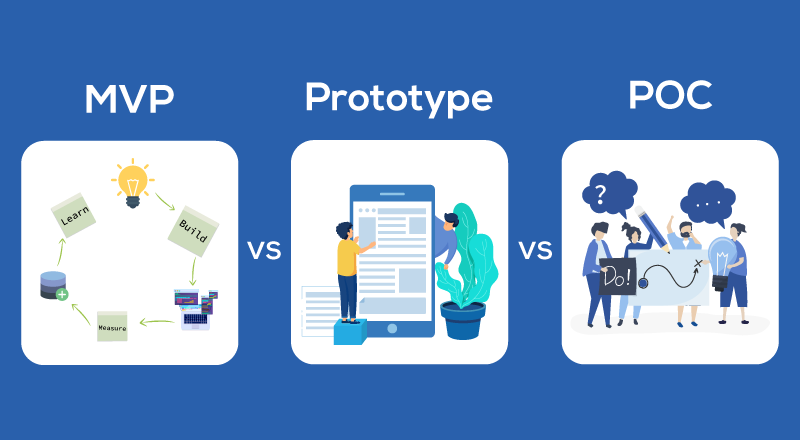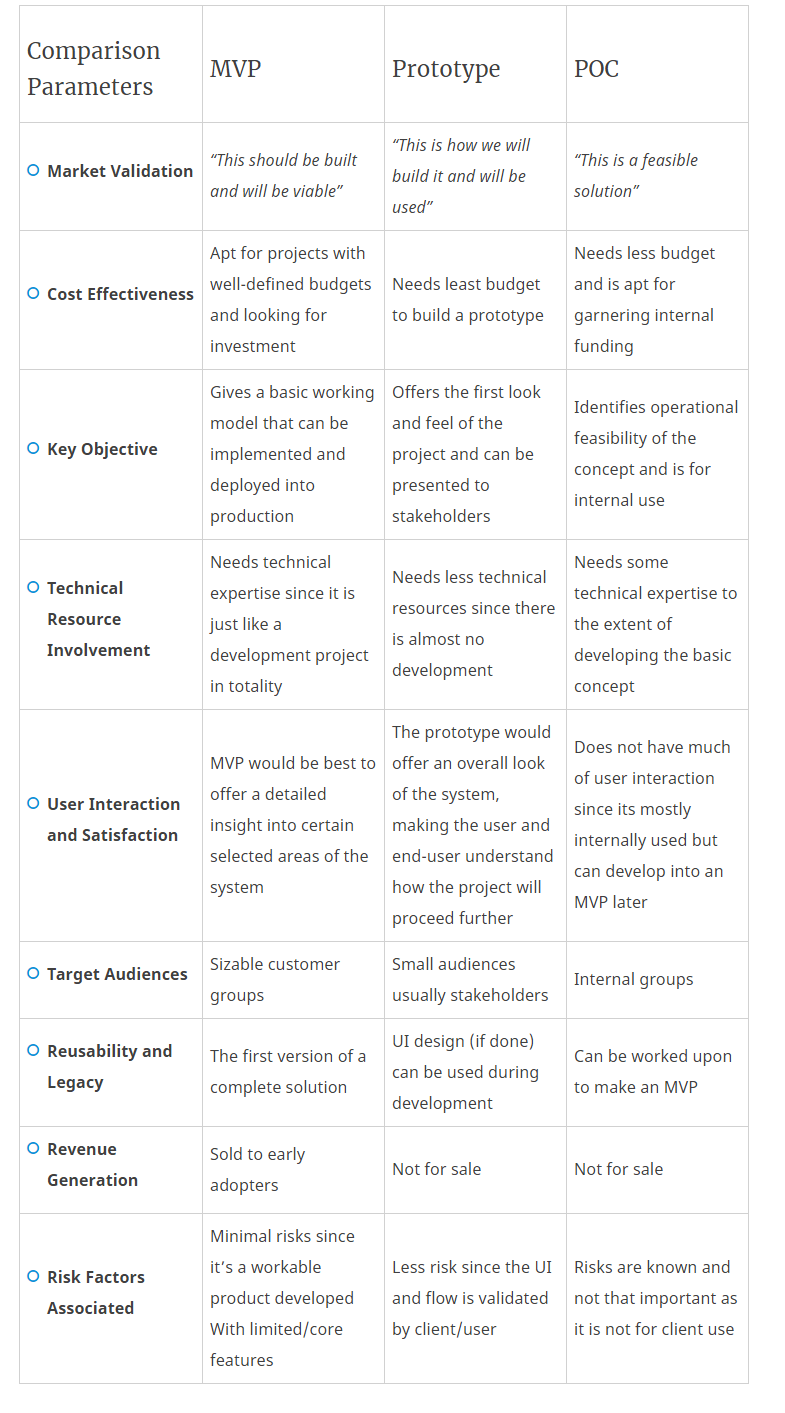Latest news about Bitcoin and all cryptocurrencies. Your daily crypto news habit.
MVP Vs Prototype Vs POC — A Complex Choice of Strategy Made Simple
While implementing new Ideas or new features in the existing system most organizations [Start-ups or Enterprises] are unable to decide what strategy to adapt for developing their product or evaluating the idea and its feasibility. The results any organizations expect is a satisfied customer, the right transformation of ideas into an actual product, and better ROI.
The three fundamental strategies that organizations go for are Proof of Concept (POC), Prototype and Minimum Viable Product (MVP). The dilemma when choosing an MVP, POC and Prototype can at times lead towards an incorrect selection. By doing so, an organization may end up leaking their finances, wasting their effort, time and it may affect the business growth overall.
Each of these can be used independently or together depending on the project plan/roadmap. All these 3 approaches have their shades of features, objectives, operations, and benefits. Let us first understand each of them and then move towards comparing them with each other.
MVP, Prototype, POC — An Overview
Proof of Concept (POC)
“Proof of concept (PoC) is a realization of a certain method or idea in order to demonstrate its feasibility or a demonstration in principle with the aim of verifying that some concept or theory has practical potential” — Wikipedia
As its name suggests, this can be the best approach to verify the uncertain idea or the concept’s feasibility for the practical implementation. It is used before the actual development of the product and before the product is launched in the market.
For developing POC, a small project is implemented to verify if certain concepts can be implemented (both in terms of business models and technical capabilities).
POC is usually not shown publicly or to the customer. It may not be usable at all since its major focus is to verify if the fundamental idea is operationally workable or not. Building a POC needs a good amount of time and effort for the development. It helps you assess if the project will run flawlessly [technically] or not, based on the initial study. POC is all about testing if the concept will work further or not. If not, it might as well be altered/aborted at the start.
A POC usually is made to depict an area of the system and hence certain projects may need multiple POCs to showcase different components. If the POC is successful, the project moves ahead else it may take a different route or may stop even. In case of a positive POC, there are higher chances of getting initial buy-in from stakeholders with further financial help build prototypes. A POC may/may not be reusable, fully secure and scalable as it is used to validate the idea and its feasibility.
Key Features of POC
- Demonstrates feasibility and confirms potential
- Exposes a realistic implementation of a small portion of the whole system
- Less cost and time for feature validation compared to full-scale project
- Gives way to innovative ideas right in the initial stage
- Discloses errors, bugs, and risks involved at an early stage
- Gives a ‘yes’ or ‘no’ instantly to the viability of your project
When do you need POC?
POC is needed when you are not sure or uncertain about the acceptance of the idea. It might be because; you are trying to implement the original and fresh idea or you are trying to provide some cost-effective product which was earlier done with high investment. Whatever the reason is, POC will provide you the clear picture whether your idea is viable or not.
Prototype
“A prototype is an early sample, model, or release of a product built to test a concept or process or to act as a thing to be replicated or learned from” — Wikipedia
A prototype focusses on determining how the product will be done, its look and user flow. It is an important aspect of the project as it helps in understanding the fundamental project workflows, their usability and special features to be included. It is an interactive model of the system that facilitates users to visualize the experience in a better manner. Though it may not be a standalone system, it does give a clear idea of how the product would look like. Initial errors in study and designing can be pointed out to avoid them from percolating further.
Prototyping is an appreciated method to visualize how your product will be functioned and verified with the end-user and business users. It describes the flow and gives an inclusive idea of the design and layout of your desired system. A prototype usually includes wireframes (paper, interactive), design layouts, mock-ups, and user flows. It could be a working prototype, visual prototype, user experience prototype, and functional prototype.
Key Features of Prototype
- Early feedback on the product
- Identification of mistakes in the design and development phases
- Increased acceptance by users owing to the visual effect
- Less expensive and lucrative and faster
- Simplifies complex ideas into an understandable format
- Application/System flow validation by business users
Minimum Viable Product (MVP)
“A minimum viable product (MVP) is a product with just enough features to satisfy early customers and to provide feedback for future product development” — Wikipedia
An MVP is a functional product that has enough features for it to be shipped to its initial set of users. Starting from basic concept to reality, MVP is a standalone and primary system on its own. It represents the fundamental version of your system catering to a small set of users and is offered to them for further usage and comments.
Eric Ries, the author of ‘The Lean Startup’ defines MVP as ‘that version of a new product which allows a team to collect the maximum amount of validated learning about customers with the least effort’
Implementing an MVP has its own set of benefits like sensible pricing, faster time to market, reduced risks, immediate value, minimal development costs and augmented flexibility. The MVP process helps you verify product feasibility, team assumptions about the product, usability and market demand. It facilitates in building a product that has minimal features and iteratively helps in building a better version of the product by leveraging end-user feedback and come up with best decisions. Stage wise, the product evolves and offers maximum ROI with increased maturity. Here are two of the known examples that have tasted success based on this model:
- Dropbox is one of the most successful organizations which started its venture at a small scale with an objective to establish a service all can use. They did face their own set of challenges in terms of integration with different environments, but they caught the attention of Steve Jobs and garnered a lot of funding, popularity, and success soon.
- Uber is one of the most used taxi apps today, all over the globe. As they started, they didn’t have most of the features that are available today. There were just bare minimum features that were offered. Gradually, they built extensive features one after the other, observing the fate of the previous one. That gave them a live effect of the app that their users were happy with and feedback on improvements that were needed to make it a better experience.
Key Features of MVP
- Increased Production Readiness
- Offers right subset of features to keep users satisfied
- Creates value for users with continuous feedback and improvement
- A minimal form of your complete product
- Gives valuable insights to grow gradually keeping customers in mind
- Garners high retention in a small investment
- Helps in preventing wastage of time, money and efforts
- Set the path for increased feasibility and value
When do you need MVP?
Generally, MVP is the right choice if you want to check the demand of your product, analyze the behavior and preference of your target audience and want to release the product in a short time with minimal features.
Key Considerations Prior to Developing an MVP, Prototype or POC
Prior to deciding whether you need to develop a prototype, POC, or MVP, there are certain questions which need to be clearly answered and perceived. Once the answers to these questions are well understood, the decision to choose from these three is surely a correct one.
- Who is your target audience for this product? And what is the value addition?
- What are your validation criteria?
- What do you want to verify?
- What does your business really need?
- What is your budget, time and effort estimation?
- What is your target output in terms of functionality and production readiness?
- Is your terminology for the project defined and discussed?
MVP Vs Prototype Vs POC — A Scaled Comparison
MVP, Prototype, POC- When to Choose Which Method?
When it comes to choosing among these three becomes quite tricky. Here is a list of certain parameters, pre-conditions, questions that can help choose which one would fit the bill.
The above checklist is attempted to cover most possible conditions, but some organizations may feel the need for a combination of the above. In such cases, a mechanism can be worked out that can take two of them and implement them one after the other, as the situation demands.
On a Parting Note
All three — MVP, Prototype and POC have their distinct set of characteristics based on which organizations can choose which one suits their scenario the best. The above article has attempted to make it very clear to the reader when to choose what and what exactly are the comparison factors amongst the three. And, hope it has succeeded in doing so.
This post was originally published on our blog: here
MVP Vs Prototype Vs POC — A Complex Choice of Strategy Made Simple was originally published in Hacker Noon on Medium, where people are continuing the conversation by highlighting and responding to this story.
Disclaimer
The views and opinions expressed in this article are solely those of the authors and do not reflect the views of Bitcoin Insider. Every investment and trading move involves risk - this is especially true for cryptocurrencies given their volatility. We strongly advise our readers to conduct their own research when making a decision.


